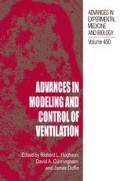Abstract
The input-output relationship of the CO2 respiratory controller can be described in two different ways. The first method is to describe the output as a function of the inputs; this type of controller model may be called a reflex controller model. The other method is to describe the relationship by an operating principle. The operating principle is often the minimization of a certain criterion or parameter; in this case, the controller is called an optimal controller. Several investigators have proposed that the respiratory controller responds to various stimuli in order to minimize certain criteria, which represent the energetic cost of breathing (3,4,9,13). In the concept proposed by Poon (9), the maintenance of arterial blood gas tensions and mechanical work are competing priorities for the respiratory controller, and the controller functions to minimize the net operating cost of both work and deviations of the blood gas tensions from given set points.
Access this chapter
Tax calculation will be finalised at checkout
Purchases are for personal use only
Preview
Unable to display preview. Download preview PDF.
References
Chonan, T., M.B. Mulholland, M.D. Altose, and N.S. Cherniack. Effects of changes in level and pattern of breathing on the sensation of dyspnea. J. Appl. Physiol. 69: 1290–1295, 1990.
Dick, T.E., Y. Oku, J.R. Romaniuk, and N.S. Cherniack. Interaction between central pattern generators for breathing and swallowing in the cat. J. Physiol. Lond. 465: 715–730, 1993.
Longobardo, G.S., N.S. Cherniack, and A. Damokosh-Giordano. Possible optimization of respiratory controller sensitivity. Ann. Biomed. Eng. 8: 143–158, 1980.
Luijendijk, S.C.M., and J. Milic-Emili. Breathing patterns in anesthetized cats and concept of minimum respiratory effort. J. Appl. Physiol. 64: 31–41, 1988.
Muro, S., Y. Oku, K. Chin, M. Mishima, M. Ohi, and K. Kuno. The effect of ventilatory assist on the level of respiratory drive in decerebrate cats. Resp. Physiol. 109: 205–217, 1997.
Oku, Y, G.M. Saidel, T. Chonan, M.D. Altose, and N.S. Cherniack. Sensation and optimization of breathing: A dynamic model. Ann. Biomed. Eng. 19: 251–272, 1991.
Oku, Y, G.M. Saidel, M.D. Altose, and N.S. Cherniack. Perceptual contributions to optimization of breathing. Ann. Biomed. Eng. 21: 509–515, 1993.
Oku, Y., I. Tanaka, and K. Ezure. Activity of bulbar respiratory neurons during fictive coughing and swallowing in the decerebrate cat. J. Physiol. Lond. 480: 309–324, 1994.
Poon, C.S. Ventilatory control in hypercapnia and exercise: Optimization hypothesis. J. Appl. Physiol. 62: 2447–2459, 1987.
Remmers, J.E., and H. Gautier. Servo respirator constructed from a positive-pressure ventilator. J. Appl. Physiol. 41: 252–255, 1976.
Swanson, G.D. The exercise hyperpnea dilemma. Chest 73: 270–272, 1978.
Ward, S.A., and B.J. Whipp. Ventilatory control during exercise with increased external dead space. J. Appl. Physiol. 48: 225–231, 1980.
Yamashiro, S.M., J. A. Daubenspeck, T.N. Lauritsen, and F.S. Grodins. Total work rate of breathing optimization in CO2 inhalation and exercise. J. Appl. Physiol. 38: 702–709; 1975.
Younes, M. Proportional assist ventilation, a new approach to ventilatory support. Theory. Am. Rev. Respir. Dis. 145: 114–120, 1992.
Author information
Authors and Affiliations
Editor information
Editors and Affiliations
Rights and permissions
Copyright information
© 1998 Springer Science+Business Media New York
About this chapter
Cite this chapter
Oku, Y., Muro, S. (1998). Are the Respiratory Responses to Changes in Ventilatory Assist Optimized?. In: Hughson, R.L., Cunningham, D.A., Duffin, J. (eds) Advances in Modeling and Control of Ventilation. Advances in Experimental Medicine and Biology, vol 450. Springer, Boston, MA. https://doi.org/10.1007/978-1-4757-9077-1_24
Download citation
DOI: https://doi.org/10.1007/978-1-4757-9077-1_24
Publisher Name: Springer, Boston, MA
Print ISBN: 978-1-4757-9079-5
Online ISBN: 978-1-4757-9077-1
eBook Packages: Springer Book Archive

